
About UsThe Numismatic Bibliomania Society is a non-profit organization promoting numismatic literature. For more information please see our web site at coinbooks.org SubscriptionsThose wishing to become new E-Sylum subscribers (or wishing to Unsubscribe) can go to the following web page link MembershipThere is a membership application available on the web site Membership Application To join, print the application and return it with your check to the address printed on the application. Membership is only $15 to addresses in the U.S., $20 for First Class mail, and $25 elsewhere. For those without web access, write to: David M. Sundman, Secretary/TreasurerNumismatic Bibliomania
Society AsylumFor Asylum mailing address changes and other membership questions, contact David at this email address: dsundman@LittletonCoin.com SubmissionsTo submit items for publication in The E-Sylum, just Reply to this message, or write to the Editor at this address: whomren@coinlibrary.com
BUY THE BOOK BEFORE THE COINYou won't regret it! |
- WAYNE'S WORDS: THE E-SYLUM MAY 22, 2011
- DAVID SKLOW MAIL BID SALE NO. 13 CLOSES JUNE 11, 2011
- HAPPY 100TH BIRTHDAY TO ERIC NEWMAN!
- WILLIAM H. MCDONALD, 1924-2011
- NOTES FROM E-SYLUM READERS: MAY 22, 2011
- BITCOIN: ANOTHER ONLINE CURRENCY
- THE DAVID HEUER COLLECTION TO BE OFFERED BY BALDWIN'S
- GOLD COIN HOARD UNCOVERED BY BUILDERS IN AUSTRALIA
- THE EURO COIN SIZE SWITCHEROO
- FEATURED WEB PAGE: NORTH CAROLINA COLONIAL PAPER MONEY Click here to read this issue on the web
WAYNE'S WORDS: THE E-SYLUM MAY 22, 2011

We have no new subscribers this week (as of Thursday, anyway). We have 1,425 email subscribers, plus 140 followers on Facebook, including Brandon Katrena and Norbert Wegmann.
This week's issue is brought to you with the able help of NBS webmaster Bruce Perdue, who filled in over the weekend while I traveled with my family. In a cold-turkey experiment, I left my laptop at home as a surprise to my wife, who figured they would someday need the Jaws of Life to pry it from my cold, dead hands. That or a six-foot power cord cable for the coffin.
So for the first time since September 4, 1998 I had to spend Sunday night watching my inbox like every other E-Sylum subscriber. Looks like it worked! Thanks, Bruce! I'll be back on the job next week, so keep your emails coming.
Topics this week include a very special numismatist's birthday celebration, the David Heuer collection, euro coin sizes and another attempt to make a true electronic currency. Have a great week, everyone.
Wayne Homren
Numismatic Bibliomania Society
DAVID SKLOW MAIL BID SALE NO. 13 CLOSES JUNE 11, 2011
David Sklow forwarded the following reminder of his upcoming numismatic literature sale. He writes:
A reminder so you will not miss MBS # 13, June 11th Sale! Our largest sale to date - over 1,000 lots!
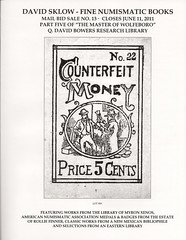
DAVID SKLOW - FINE NUMISMATIC BOOKS
MAIL BID SALE NO. 13 CLOSES JUNE 11, 2011
PART FIVE OF "THE MASTER OF WOLFEBORO"
Q. DAVID BOWERS RESEARCH LIBRARY
From the research & source library of Q. David Bowers are offered over 300 lots on numismatics. Including an American Bond Detector; an Original set of Numisma by Frossard; set number 5 of the deluxe bound Armand Champa Library catalogs; letters between QDB and John J. Ford, Jr.; the paste-up plates for the Taylor sale of Colonials 1987; super deluxe presentation copy number 2 of the Eliasberg & Brand collections; a set of The Essay Proof Journals; special, priced, large paper, bound, Cogan Sale of the J.K. Wiggins Collection; six works by Snelling bound in one volume; over 125 Director of the Mint reports 1852-1977; Bankers Magazine and Statistical Register, ex: John J. Ford Jr.; 65 lots of Bank Histories;
The sale also features classic selections from the library of numismatic publisher and literature dealer Myron Xenos, to include hundreds of 19th and 20th century auction catalogs, An Essay on Medals by Pinkerton, and numerous works on coinage of China, Japan and the Far East.
Over one thousand-three hundred color photographs of Large Cents 1816-1843 by William Noyes.
Library from New Mexico, featuring deluxe bound auction catalogs, numerous standard reference works, some deluxe editions and original Early Coins of America by Crosby.
A beautiful example of Medals & Medallions Relating to Architects by Eidlitz.
Badges & Medals of the American Numismatic Association, from the estate of Rollie Finner. Including the very rare 1991 Centennial three piece medals set, bronze, silver & gold in special presentation wooden box.
Bidders may enter bids by mail, telephone, email or fax. The sale closes at 8pm mountain time, June 11, 2011, however, any bids left on our answering machines or sent by email or fax on or before midnight on closing day will be accepted.
The most "dedicated" Numismatic Literature Auction firm in the United States
Sale Catalog is viewable on our web site
DAVID SKLOW - FINE NUMISMATIC BOOKS
P.O. BOX 6321
COLORADO SPRINGS, CO 80934
TEL: (719) 302-5686
FAX: (719) 302-4933
finenumismaticbooks@aol.com
www.finenumismaticbooks.com
THE BOOK BAZARRE
HAPPY 100TH BIRTHDAY TO ERIC NEWMAN!
One time on my way to an ANA convention on the West Coast my plane had a layover in St. Louis, and who walked on board but Eric himself! He recognized and greeted me, and we sat together and talked the remaining length of the flight. Such a gentleman! On an earlier occasion I attended an Early American Coppers convention in St Louis, and Eric graciously agreed to my bold request to visit his numismatic library. I had the time of my numismatic life getting a private tour of his wonderful numismatic museum and library.
I spoke to Eric Thursday afternoon and he's doing quite well. He's a regular E-Sylum reader and makes good use of the internet to help with his research. He told me how much easier research is today - before he had to write letters and sometimes go in person to poke around libraries and museums to locate information. He's hard at work on this latest numismatic research project.
Eric, I can't thank you enough for your friendship and your unmatched contributions to American numismatic history and literature. Congratulations on yet another milestone - Happy Birthday! -Editor
Tom DeLorey published an article about Eric in the May 2011 issue of COINage magazine. Here's the introduction:
In my numismatic life, I have been privileged to see and hold a great many numismatic wonders, including at various times five different examples of the famous (and infamous) 1804 silver dollar. An even greater thrill was being able to hold all five of the 1913 Liberty Nickels in my hand at the same time, at the 2003 convention of the American Numismatic Association in Baltimore.
Eric Pfeiffer Newman, the greatest living American numismatist, used to own all five - at the same time. What's more amazing is that he bought them in 1942, when he was just 30, nd he is still with us today as a national treasure - at the glorious age of 100.
I first met Eric Newman at the offices of Coin World in the mid-1970s. I was about 25, with oh, so much to learn about numismatics, but he was ever the gentleman, despite being 40 years my senior. I think we discussed the groundbreaking work The Fantastic 1804 Dollar, which he co-authored with Ken Bressett in 1962.
It was a book that made handling those 1804 dollars over the years so special to me. I knew I could never afford to own one, but Eric's writing made me want to own one.
Over the years, especially when I was an authenticator for the ANA Certification Service, I had occasion to speak with him about other things, such as the questionable United States Assay Office of Gold 1853 $20 coins associated with his long-time adversary, John J. Ford. Newman was always willing to support the ANA in attempting to resolve the decades-old controversy surrounding these pieces, about which he was ultimately proven right, and a delight to speak with about other topics as well.
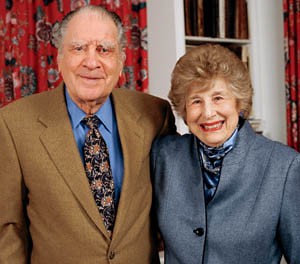
Eric and Evelyn Newman
Joel Orosz writes:
The following words were spoken in 1964 by Harold Macmillan about Sir Winston Churchill, but I think they apply perfectly to my good friend and mentor, Eric P. Newman, on the happy occasion of his centenary birthday:
"The life of the man whom we are honouring is unique. The oldest among us can recall nothing to compare with him, and the younger ones among us, however long we live, will never see the like again."
George Kolbe writes:
"If you want to live a long life, focus on making contributions." If these words by scientist Hans Selye are true, you will surely enjoy many more birthdays. Congratulations on a most memorable one.
Dennis Tucker of Whitman Publishing writes:
"The opportunity to collaborate with Mr. Newman has been an honor and a privilege. Best wishes for a wonderful 100th birthday, and many more!"
Keith Zaner of Whitman Publishing adds:
"I'd like to extend my best wishes to Eric Newman for a very happy birthday."
David F. Fanning writes:
Eric P. Newman established himself as a numismatic scholar in the 1940s, though he had been active in the hobby in other ways for quite some time. More than sixty years later, he remains an active contributor to numismatic scholarship in the United States and it is difficult to think of anyone else who has created a similar body of work in the field of early American numismatics. While other important scholars have published as widely as Mr. Newman has, rarely do we encounter the sheer depth of scholarship seen in Newman's work.
Numismatics is a science and, as with all scientific endeavors, obsolescence comes with the territory: science builds upon itself and is constantly revising. What is remarkable in the case of Eric Newman is that his work has stood the test of time so well. In most cases where revisions and emendations of his previously published works became necessary, Mr. Newman took on the task himself. He recognized early on that new data need constantly to be integrated into the published record, and that this continual process of revision keeps scholarship alive. If one can point to one of his older publications and say that it is out of date and has been surpassed by more recent scholarship, odds are that the more recent scholarship was also penned by Mr. Newman. This tendency to revise has kept his work fresh and vibrant and is a model for others to follow.
It is one thing to become an expert in a field and to acquire, through hard and often tedious work, truly specialize knowledge of a particular subject. It is another thing to make the decision to share that knowledge. The temptation to keep one's hard-won knowledge to oneself is real. Arrogance and greed are, regrettably, motivators that have done much to check the progress of numismatic science. Eric Newman made the decision early on to share the fruits of his labor with the wider numismatic community, and we are all richer for it. Because of this, he and his work will be remembered long after those of his peers who chose to hoard knowledge for themselves have been forgotten.
I wish Mr. Newman a very happy 100th birthday. He is a remarkable man and has led a remarkable life. I look forward to reading more of his works and I dearly value my friendship with him.
On Facebook BK's Chasing History wrote
"I don't know Mr. Newman but I know of him and I think I can say that most all of us would be thrilled to live a life as spectacularly as he has! Happy Birthday sir!"
Also chiming in on Facebook, Julian Leidman writes:
"Happy 100th to one of the greatest numismatists of all time. So happy that you are well and can celebrate properly. Wishing you many more years of enjoyment!"
Dan Hamelberg writes:
A life full of challenges and adventure. Eric has done it all. He has certainly engaged and excelled in the world of numismatics. During one of my visits to St. Louis, Eric shared with me one of his great adventures.
After marrying the girl of his dreams, they traveled for their honeymoon to a coastal town in S. America. The world was on the brink of war, and it was reported that the Germans intended to dock a warship in the harbor of the town where Eric and his new bride were celebrating their marriage. The town's people did not like this idea, so they decided to react. They floated a barge to the entry canal of the harbor, and sank it to block the German warship from entering. Eric was right there to witness this. When the news of this hit the wire services, his new in-laws back home were frantic. Eric composed a poem to explain the "adventure", and sent it as a telegram to ease the worry back home. No problem. Eric and his best partner had started their great adventure. Happy birthday, Eric. May the adventure continue.
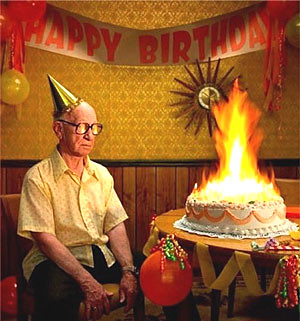
Happy Birthday, Eric!
William H. McDonald, 1924-2011
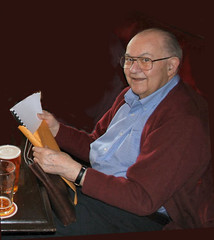 It was with a strong feeling of the passing of an era that the death of William H. (Bill) McDonald was announced on Saturday, May 14, 2011. Bill was a huge force in Canadian numismatics, founder of the CPMS (Canadian Paper Money Society), the CMNS (Classical and Medieval Numismatic Society) and the J.D. Ferguson Historical Research Foundation.
It was with a strong feeling of the passing of an era that the death of William H. (Bill) McDonald was announced on Saturday, May 14, 2011. Bill was a huge force in Canadian numismatics, founder of the CPMS (Canadian Paper Money Society), the CMNS (Classical and Medieval Numismatic Society) and the J.D. Ferguson Historical Research Foundation.
Bill, born in Winnipeg in 1924 into a large family, left home to join the Navy in 1943. After the war, Bill left the west for Ottawa and Gwen joined him a year later where they were married in 1950. Bill now began his long career as a banker, eventually joining the Bank of Nova Scotia in Toronto, the city which remained his much-loved home for the rest of his life.
Bill's career climbed with the explosive growth of the post-war city; he was involved in mortgage writing for the developers of the old Henry Farm for example, which became a fine planned community and the site of the McDonalds' family home.
It was his banking career that first sparked his primary collecting interest: paper money, and specifically banknotes. His collection of these grew to enormous proportions. At one time a display of his collection at the Toronto-Dominion Centre encompassed seventy showcases. In a demonstration of the numismatic adage to buy the book before the coin, Bill put together a collection of books on banking history that filled three walls of his home library. Bill was always interested in the learning aspect of numismatics and to further spread his own commitment to paper money he founded the CPMS and with it, its publication which is still operating today.
The J.D. Ferguson Historical Research Foundation was set up in 1971 by Bill and numismatic friends to support educational activity in the field of numismatics. All funds were tax deductible and kept in perpetuity. The Foundation is a legacy to Bill's progressive and forward thinking as the Foundation has given over $200,000 to numismatic research since its inception. Bill was the founding Chair and continued in that capacity until 1999. He believed so strongly in the Foundation that he gave large donations in his family name to the Foundation over many years
After his retirement from banking, Bill felt the need of another challenge. He turned to a small collection of ancient coins he had bought and put away years before and for information about them developed a friendship with Bruce Brace, the foremost ancient numismatist of his day in Canada. Bruce introduced Bill to the rest of the ancient coin spectrum and suggested he limit himself to one facet of this very wide field. Bill wisely chose the period from 100 BC to AD 100 and for the rest of his collecting career stuck pretty closely to that.
As in the case of paper money, Bill wanted to spread information on his new interest. To this end he founded the Classical and Medieval Numismatic Society, in partnership with Bruce Brace in 1991. This was accompanied by a pair of publications: the annual Picus and the quarterly newsletter Anvil. In 2000 these two publications were replaced by a card-covered quarterly, the CMNS Journal, which contained both scholarly and general interest articles. Four issues a year were mailed from an 'assembly line' around the McDonald dining room table and the 'world-wide distribution centre' staff then made their way to the post office with 300 copies to be mailed from Toronto to Tehran, Athens to Australia. After that, the mailing team (same as the editorial team and the office staff) made their way to the Fish House for a well deserved post-publication dinner.
At one time Bill and Gwen even ran a mail order book business from their home. Called Marlcourt Books, it carried most publications in print for ancient numismatics and sent out many rare and out-of-print resources too.
Bill would be happy to know he is so much remembered for his dissemination of numismatic information. Whether it was the founding of societies, publications, books or seminars Bill was a giant in Canadian numismatics and he will be long remembered for that.
To read the complete article, see: William H. McDonald, 1924-2011 (www.nunet.ca/jdfhrf.htm)
The idea for a new Canadian numismatic bibliography was first conceived in the spring of 1995 in a conversation between Bill McDonald and Darryl Atchison. Subsequently, at the annual meeting of the Canadian Numismatic Research Society held at the Canadian Numismatic Association convention in Calgary, Alberta, a proposal was formally adopted to compile such a text. After some discussion, Ron Greene, Darryl Atchison, Paul Berry, Phillip Carrigan and Bill McDonald were appointed as the members of the Canadian Numismatic Bibliography Project Committee.
The massive two-volume work ably edited by Darryl Atchison was the culmination of a twelve-year effort, ultimately delivered to subscribers in 2007. It was well worth the wait. A cornerstone of any library devoted to Canadian numismatics (or North American numismatics, for that matter), the work is a virtual encyclopedia with far more information and text than a mere bibliography. We're grateful to Bill McDonald for his part in making this work a reality. -Editor
Tony Hine forwarded the following obituary. I included an image of Bill provided by Dan Gosling. Thanks, everyone!
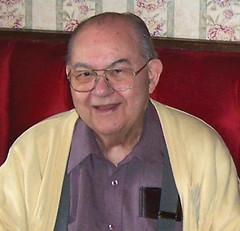 MCDONALD, William Henry - 1924 - 2011 With sadness we announce the passing of Bill, peacefully and with love surrounding him on Saturday, May 14, 2011. Bill leaves behind his loving wife of 60 years Dorothy Gwen, his daughter Barbara (Mike Irwin), his grandchildren Michael Irwin (Sheryl), Stephanie (Cale Reeder), Amanda Campbell. Bill also leaves behind his sisters, Beatrice Brooks, Alice Carrigan, Maude (Roger Poirier), Dorothy (Al Markusson), Florence (Bob Larson), sister-in-law Wanda McDonald, numerous nieces, nephews, great-nieces and great- nephews. Predeceased by brothers Norman, Gordon, Murray and Edward.
MCDONALD, William Henry - 1924 - 2011 With sadness we announce the passing of Bill, peacefully and with love surrounding him on Saturday, May 14, 2011. Bill leaves behind his loving wife of 60 years Dorothy Gwen, his daughter Barbara (Mike Irwin), his grandchildren Michael Irwin (Sheryl), Stephanie (Cale Reeder), Amanda Campbell. Bill also leaves behind his sisters, Beatrice Brooks, Alice Carrigan, Maude (Roger Poirier), Dorothy (Al Markusson), Florence (Bob Larson), sister-in-law Wanda McDonald, numerous nieces, nephews, great-nieces and great- nephews. Predeceased by brothers Norman, Gordon, Murray and Edward.
Bill served with the RCNVR, 1943-1945. He then began a career as a venture capitalist that spanned more than 50 years. During this time he was instrumental in creating a national mortgage company, and was influential in a Canadian Bank receiving its parliamentary charter. Of equal importance to Bill was his passion for the development and promotion of Canadian numismatics. He was not only a very well-respected and knowledgeable collector; he was also one of the initial founders of two of Canada's numismatic societies. His involvement in Canadian numismatics led him to be a key player in the founding of the J. Douglas Ferguson Historical Research Foundation, an educational charitable organization. Bill also ran Marlcourt Books, a company specializing in numismatics, banking and financial history.
Bill was an honourable gentleman whose gentle spirit and wonderful smile were shared with all who knew him. The family would like to express heartfelt thanks to all of the devoted caring staff of Sunnybrook Veterans Centre K2W. A private service took place on May 16, with The Rev. Canon Brad Lennon officiating. A Celebration of Bill's life will be held on June 25, 2011 from 1-5 p.m. at York Visitation Centre, 160 Beecroft Road, Toronto, ON, M2N 5Z5, 416-221-3404 or 1-888-277-2643. If friends wish, donations to the following charity would be deeply appreciated by the family: 'Veterans Comfort Fund' (please specify), Sunnybrook Foundation, 2075 Bayview Avenue, Room H332 Toronto, ON, M4N 3M5 or at www.sunnybrook.ca/foundation
To read the complete article, see:
William Henry McDonald
(www.legacy.com/obituaries/thestar/obituary.aspx?n=
william-henry-mcdonald&pid=151075017)
KOLBE & FANNING JUNE 2, 2011 SALE HIGHLIGHTS
Rare and Unusual Publications on American Numismatics IncludingA 1910 Thomas Elder sale Confederate Half Dollar illustration
unrecorded in Adams,(only the second known;
A 1908 letter from Charles Steigerwalt to Joseph Mitchelson,
(commenting on the death of De Witt Smith;
A deluxe set of John Adams bibliographies;
(A rare photographic illustration of an 1804 silver dollar
sold in an 1884 Adolph Weyl sale
Catalogue Available at Our Web Site: www.numislit.com
Printed Catalogues $10.00
KOLBE & FANNING NUMISMATIC BOOKSELLERS
141 W JOHNSTOWN ROAD, GAHANNA OH 43230-2700
(614) 414-0855 • df@numislit.com • GFK@numislit.com
NOTES FROM E-SYLUM READERS: May 22, 2011
Ralf Böpple of Stuttgart, Germany writes:
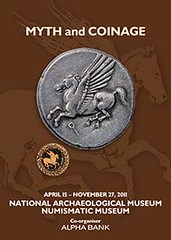 With regard to the article in Vol. 14, Number 19, I would like to inform the readership that there is indeed a publication from the Alpha Bank Numismatic Collection available. Alpha Bank has informed me that it can be ordered through Paul-Francis Jacquier of Numismatique Antique (www.coinsjacquier.com) in Kehl am Rhein / Germany. I ordered through him, and he is prepared to ship internationally.
With regard to the article in Vol. 14, Number 19, I would like to inform the readership that there is indeed a publication from the Alpha Bank Numismatic Collection available. Alpha Bank has informed me that it can be ordered through Paul-Francis Jacquier of Numismatique Antique (www.coinsjacquier.com) in Kehl am Rhein / Germany. I ordered through him, and he is prepared to ship internationally.
Regarding the Alpha Bank collection and their activities, I recommend the following link: www.alphapolitismos.gr .
To read the earlier E-Sylum article, see: EXHIBIT: MYTH AND COINAGE (www.coinbooks.org/esylum_v14n19a04.html)
Dick Johnson writes:
I love wild deer meat so when I saw the U.S. Mint invitation illustrated with a deer on the Olympic National Park Quarter I eagerly was about to RSVP my acceptance until I read further to my disappointment. The invitation said come attend the "ceremonial LAUNCH." Not lunch!
Howard Daniels wrote:
My latest Bonhams & Butterfields Sale catalog arrived this week. The NBS item in it is Lot 1478; FDR Framed Note and Gold Coins "Gift to Johnnie." There are also some US Large Cents to Modern commemorative and bullion pieces; some US Currency; the Jeffries vs Johnson, July 14, 1910 Boxing Medal (watch fob); and some world coins that includes two of the Russian gold proof 100 Roubles coins for the 1979 Olympics. For those interested in this sale, they can go to www.bonhams.com/us. Howard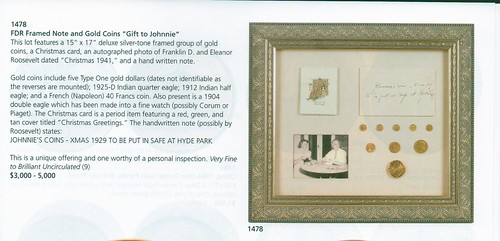
Scott Tappa,
World Coin News Available In Digital Format
Subscribe now and get this leading source of international coin news and commentary delivered to your Inbox!
Whether you are new to the world of coins or an experienced numismatist, World Coin News provides all the information you need and more. Not only can you count on World Coin News to deliver the latest information on mintages, auctions and new releases, you can also expect to find in-depth coverage like:
- Roundups of important sales, including auctions of the rarest South African coin and a 2,000-year-old Celtic coin
- Broad reporting on the newest issues, from the Austrian Mint's "Rome on the Danube" to new additions to the stunning UNESCO series
- Looming monetary changes for individual nations, including upcoming modifications to the Canadian "loonie" and the possible reinstatement of the Greek drachma
In addition, noted numismatic writer, researcher, auction cataloger and coin dealer Richard Giedroyc shares his expertise in the column, "Around the World". We even have features on animals that you find on coins, to fill you in on why they're important enough to be on there in the first place.
Get a full year of World Coin News (12 issues) and get all the expert information you need! With this exclusive digital subscription; access to this valuable information will be delivered directly to your Inbox in a digital PDF file you can download to your computer desktop.
For more information please visit More Information.
Please note: The digital subscription is a separate subscription from your print subscription.
BLUE OLDER SISTER: "HEY! WHAT ABOUT ME!"
BitCoin: Another Online Currency
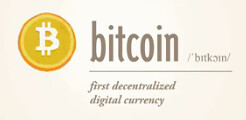 Over the past decade or so, there have been dozens of attempts to create a new kind of electronic currency that people could use for online transactions - there was CyberCash and DigiCash, and even smaller startups with bizarre names like Beenz and Flooz. None of them managed to gain much traction, but that hasn't stopped a
group of hackers from trying to launch a new "peer-to-peer" currency called Bitcoins. Although some of its supporters are optimistic about the potential for this new kind of open-source e-money, the venture is fighting a massive uphill battle: for one thing, Bitcoin may actually turn out to be illegal.
Over the past decade or so, there have been dozens of attempts to create a new kind of electronic currency that people could use for online transactions - there was CyberCash and DigiCash, and even smaller startups with bizarre names like Beenz and Flooz. None of them managed to gain much traction, but that hasn't stopped a
group of hackers from trying to launch a new "peer-to-peer" currency called Bitcoins. Although some of its supporters are optimistic about the potential for this new kind of open-source e-money, the venture is fighting a massive uphill battle: for one thing, Bitcoin may actually turn out to be illegal.
The project was started by programmer Satoshi Nakamoto in 2009. But it has picked up steam during the past several months, in part because of some publicity around the project. Bitcoin also benefited a bit from the controversy over PayPal cutting off the ability to send money to WikiLeaks, which for some raised red flags about one company's ability to impede the transfer of money. One of Bitcoin's features is that it is completely decentralized, and so is theoretically immune to censorship or restraint. It doesn't require the use of a bank or payment-handling system like PayPal (which is blocking Bitcoin payments, coincidentally enough).
Bitcoin isn't the only venture that is going after the e-currency pie: we've written before about Flattr, the micropayment startup founded by The Pirate Bay co-founder Peter Sunde, which is trying to create a "tip jar"-style payment system for content (the company recently launched a way to integrate payments with Twitter).
But Bitcoin is somewhat more ambitious than Flattr, or many of the other micropayment and e-currency experiments that have gone before it. Rather than simply create a kind of virtual points system in which the points can eventually be converted into "real" money - or used to buy goods, the way that frequent-flier points and other quasi-currencies (such as "Canadian Tire money") can - the founders of Bitcoin want to create a completely separate and virtual monetary system. In other words, one that could theoretically replace the existing system if enough people decided to use it.
That's the difficult part, of course. Why would anyone use a virtual currency that has no "real" value, and is based on a system run by a group of shadowy hackers? Some programmers have started to accept payment in Bitcoins, but that's not really a great indicator of a robust monetary platform - in a sense, it's just like people exchanging goods or services in a barter system, something that is a big part of what economists call the "underground" or shadow economy. Supporters (including the Electronic Frontier Foundation) promote the idea that Bitcoins are free from government interference and can't be frozen or devalued by anyone.
The idea of virtual currency isn't really that far-fetched in some ways. Money as we know it is already somewhat virtual, since the pieces of paper and bits of metal that we use to pay for things don't have any actual value themselves - their only value is that they can be exchanged at stores for things that actually have value, like food. Their underlying worth is determined by the central banking system and the government, through a series of federal guarantees, the setting of interest rates and so on (money used to be backed by physical gold in Fort Knox, but that hasn't been the case since the 1970s).
And what is Bitcoin's value backed by? Well, that's where things get complicated. The value of a Bitcoin is determined in part by supply and demand - the system is set up so that there are only a finite number of Bitcoins in existence, which prevents the problem of people just "printing" more Bitcoins the way crumbling governments have in places like Germany in the 1920s. Bitcoins are actually generated by the routine functions of a computer that is processing large mathematical problems (known as "Bitcoin mining"), so the supply is controlled, and will never exceed 21 million.
Even apart from convincing people that they should start accepting or using it as currency, however, the biggest problem Bitcoin could have is a legal one: if the U.S. government decides to treat it as a "private currency," then it could be subjected to all kinds of strict regulation - such as the need to integrate with the taxation system, or provide for exchange into U.S. currency at certain rates - or it could simply be outlawed entirely.
To read the complete article, see: How BitCoin Wants to Make Money Even More Virtual (gigaom.com/2011/05/16/how-bitcoin-wants-to-make-money-even-more-virtual/)
The David Heuer Collection to Be Offered By Baldwin's

Baldwin's are delighted to be offering The David Heuer Collection of Ancient Greek and Roman, British and Foreign coins as part of their 4th June Argentum auction. The collection comprises 151 lots amassed by the Heuer family during the 1930s - 1980s. Many of the Greek coins were bought in London during the 1950s and come complete with provenances from the main London dealers of the time.
Born in Memphis, Tenessee, David Heuer developed a passion for coin collecting from an early age, taking inspiration from his father, Douglas Heuer, who travelled frequently to the UK during the 1930s to expand his collection. Working in the hardwood business Douglas had opportunities to travel to London and purchased coins predominately through A. H. Baldwin & Sons Ltd. This tradition was continued by his son, David, when visiting the UK several years later.
David served with the United States Marine Corps during WWII and later joined the International Harvester Company, working firstly in Havana, Cuba and then moving to Durban, South Africa. Whilst living in South Africa he and his family enjoyed extensive travel to England, Italy and Egypt amongst other places. During this period David continued collecting coins, always connecting them with the history of the country at the time of minting, as this was the most integral to his collecting. He continued collecting until his retirement when he moved back to his family farm, situated just outside Memphis.
In the later years of his life David passed his collection on to his children who, after his death in 2007, decided to consign his collection to Baldwin's. It is their hope that whoever buys the collection, or parts thereof, will feel the same sense of history and awe that both they and their father experienced during his years of collecting.
To visit the Baldwin's web site, see: www.baldwin.co.uk
THE BOOK BAZARRE
Gold Coin Hoard Uncovered By Builders in Australia
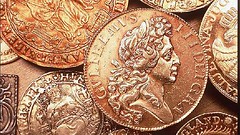 HUNDREDS of historic gold coins have been uncovered by building workers in Albany, on WA's south coast.
HUNDREDS of historic gold coins have been uncovered by building workers in Albany, on WA's south coast.
Albany police confirmed the reports that workers doing excavations on Stirling Terrace had found around 300 gold sovereigns buried under concrete.
Initial reports said the sovereigns dated back to the year 1800, and were worth more than $500,000.
Albany was the first settlement in WA, established in December 1826, even before the Swan River colony which led to the Perth's early development.
The town's The Rare Coin Company managing director Rob Jackman queried those claims, saying sovereigns were a common coin and more importantly, they weren't in production until 1817.
Mr Jackman, who has 30 years experience with rare coins, said he had not yet seen the coins but queried the initial report and their estimated value.
"They didn't make a sovereign in 1800," he said.
"They're very, very common coins.
"Until we see them, we would just estimate their value at around $320 to $330 per coin, the gold bullion price.
"They would have to be in very top condition for that price ($500,000), but if they've been buried, they're likely to be damaged. It seems exaggerated."
However Mr Jackman said the discovery was significant and he had never heard of an antique coin find of that magnitude in Albany before.
To read the complete article, see:
Builders dig up $500,000 in gold coins in Albany, Western Australia
(www.heraldsun.com.au/news/national/worth-of-historic-gold-coins
-dug-up-in-albany/story-e6frf7l6-1226058465936)
The Euro Coin Size Switcheroo
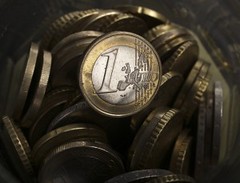 The ECB recently engaged in an unusual bit of currency intervention that went entirely unnoticed by the world's financial markets.
In a manner of speaking the move was aimed at preserving the strength of the euro but not in the way you might think.
This time it stepped in to stop euro coins becoming thinner. More than ten years since the euro's introduction, EU lawmakers are in the process of setting the physical dimensions of euro coins in stone.
The ECB recently engaged in an unusual bit of currency intervention that went entirely unnoticed by the world's financial markets.
In a manner of speaking the move was aimed at preserving the strength of the euro but not in the way you might think.
This time it stepped in to stop euro coins becoming thinner. More than ten years since the euro's introduction, EU lawmakers are in the process of setting the physical dimensions of euro coins in stone.
Thinking it what be a simple job they copy-and-pasted the original sizes set out back in 1998. Unfortunately, however, those dimensions were never really used by euro zone minters. If you measure a one euro coin for example, it is likely to by 2.33 mm rather than the 2.125 mm that was originally stipulated, while a 2 euro coin will be 2.2 mm rather than 1.95 mm.
The ECB therefore ruled that to avoid confusion and all the hassle involved in replacing every ticket machine in the euro zone, the best approach would be to change to numbers on the legal document.
Seems a sensible move, the only question I guess is do bigger coins carry a greater inflation threat?
To read the complete article, see:
ECB currency intervention of a different kind
(blogs.reuters.com/macroscope/2011/05/17/
ecb-currency-intervention-of-a-different-kind/)
FEATURED WEB PAGE: North Carolina Colonial Paper Money
This week's Featured Web Page is on North Carolina Colonial Paper Money.All of the colonies that were to form the United States issued paper money. Massachusetts was first in 1690. North Carolina authorized its first paper money in 1712 and issued it in 1713, making the Old North State the eighth colony to resort to the necessary but disliked form of money.
Paper money was considered better than no means of exchange, and North Carolina, like the other colonies, relied on a paper money economy for most of the 18th century. The paper money habit continued into early statehood, ending with the issues emanating from 1785 legislation. The State did not issue more paper money, with the exception of a few issues in the 1814-1824 period, until the proliferation of treasury notes during the Civil War. After the colonial period, state and federal governments generally shied away from paper money until the feds began in earnest to print paper money during the Civil War. By then there was no turning back to a hard money-only economy.
Issues of North Carolina colonial paper money are identified by the legislation that enabled them. Usually, but not always, there is reference in the text on the note to that legislation, including a passage or legislative session date. There are 25 different issues, each with several denominations.

oldnote.org/nccolonialpm/
